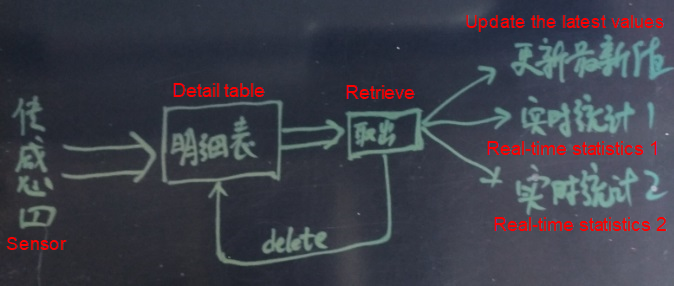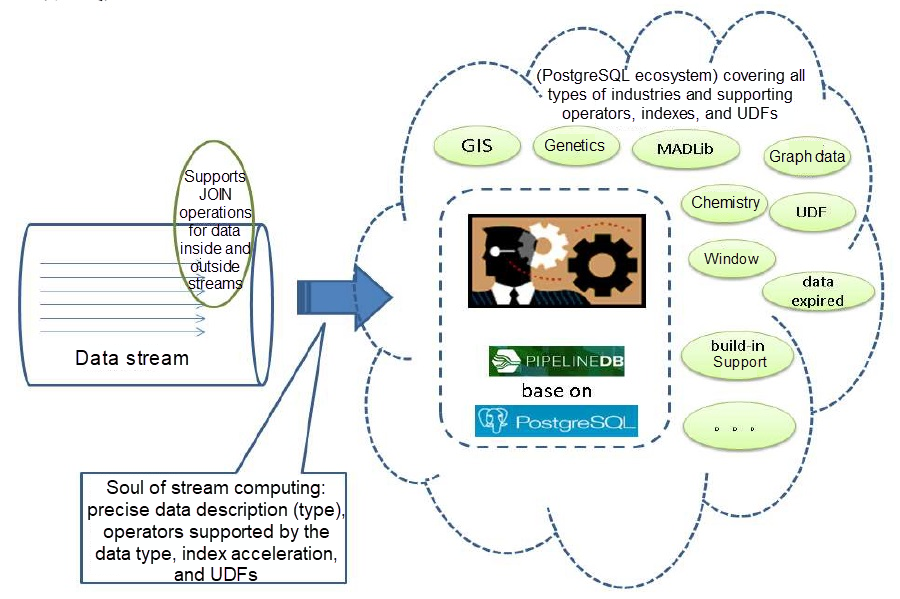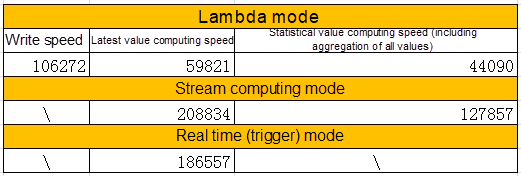By Digoal.
More and more data, especially financial data, Internet of Things (IoT) sensor-collected data, and online gaming data, is being increasingly involved in real-time analysis, aggregation, and search applications. And given such trends, it is important to be able to find a powerful and effective means of processing data-specifically, figuring out how to quickly and efficiently write and update data as it is being collected in real time.

Following this trend, in this article, we will look at the advantages and disadvantages of using three major methods: data streaming, the Lambda architecture, and synchronous real-time data analysis (or triggered mode). We will pay most of our attention to how writing and updating of data collected in real time works with these different methods.
In this article, we will assume a case where one million sensors are deployed and where each sensor periodically reports data. The user requirements for this data processing scenario are as follows:
The data volume may reach several hundred terabytes. To meet the preceding four requirements, the system needs to compute the data in real time or near real time.
For this scenario, you can employ the following design:
create table sensor_data(
pk serial8 primary key, -- Primary key
ts timestamp, -- Timestamp
sid int, -- Sensor ID
val numeric(10,2) -- Data
); Each piece of data, as shown above, includes the information shown above, which is the primary key, timestamp, sensor ID, and the data output itself.
First you'll receive the latest data value collected by each sensor.
create table sensor_lastdata(
sid int primary key, -- Sensor ID, which is the primary key
last_ts timestamp, -- Timestamp
last_val numeric(10,2) -- Value
); The information that you'll see include all the values of each sensor in each period of time (let's say, for example, an hour), as well as other values including the sum value, the record count, the maximum value, the minimum value, the average value, and value variance, as shown below:
create table sensor_aggdata(
sid int, -- Sensor ID
ts_group varchar(10), -- Group by time, such as by hour (yyyymmddhh24)
sum_val numeric, -- Sum
min_val numeric(10,2), -- Minimum value
max_val numeric(10,2), -- Maximum value
avg_val numeric(10,2), -- Average value
count_val int, -- Count
all_vals numeric(10,2)[], -- Detail value
unique (sid,ts_group) -- Unique constraint
); Last you can collect the statistics of the data reported by sensors based on region or other dimensions in real time.
To retrieve the latest values of each sensor ID (SID) using SQL statements, you can use either the aggregation or window function. But before you do either one of these, insert a batch of test data.
postgres=# insert into sensor_data(ts,sid,val) select clock_timestamp(), random()*100, random()*10000 from generate_series(1,100000); Let's consider using one of these functions, for instance. Of the options, let's first consider aggregation. For this method, you'll want to group data based on the sensor ID (abbreviated SID), aggregate VAL into arrays (in descending order based on the primary key of each individual data record), and last obtain the first value of each array.
For more reference, check out this article: Aggregate Functions. Next, below is code example that uses this method:
postgres=# select sid, (array_agg(ts order by pk desc))[1] as last_ts, (array_agg(val order by pk desc))[1] as last_val from sensor_data group by sid;
sid | last_ts | last_val
-----+----------------------------+----------
0 | 2017-05-18 14:09:10.625812 | 6480.54
1 | 2017-05-18 14:09:10.627607 | 9644.29
2 | 2017-05-18 14:09:10.627951 | 3995.04
3 | 2017-05-18 14:09:10.627466 | 840.80
4 | 2017-05-18 14:09:10.627703 | 1500.59
5 | 2017-05-18 14:09:10.627813 | 3109.42
6 | 2017-05-18 14:09:10.62754 | 4131.31
7 | 2017-05-18 14:09:10.627851 | 9333.88
...... Alternatively, you can use the window method, which we won't discuss here. It's actually pretty similar. Consider the below code example for some reference:
postgres=# select sid,ts,val from (select sid,ts,val,row_number() over(partition by sid order by pk desc) as rn from sensor_data) t where rn=1;
sid | ts | val
-----+----------------------------+---------
0 | 2017-05-18 14:09:10.625812 | 6480.54
1 | 2017-05-18 14:09:10.627607 | 9644.29
2 | 2017-05-18 14:09:10.627951 | 3995.04
3 | 2017-05-18 14:09:10.627466 | 840.80
4 | 2017-05-18 14:09:10.627703 | 1500.59
5 | 2017-05-18 14:09:10.627813 | 3109.42
6 | 2017-05-18 14:09:10.62754 | 4131.31
7 | 2017-05-18 14:09:10.627851 | 9333.88
...... Well, in our opinion, which function and method do we think is better in the end? Well, to answer this, let's check out the execution plans. As a summary, the window method has a bit faster of an execution time; however, they're both pretty fast.
postgres=# set work_mem ='16MB';
SET
postgres=# explain (analyze,verbose,timing,costs,buffers) select sid, (array_agg(ts order by pk desc))[1] as last_ts, (array_agg(val order by pk desc))[1] as last_val from sensor_data group by sid;
QUERY PLAN
------------------------------------------------------------------------------------------------------------------------------------
GroupAggregate (cost=7117.15..7823.57 rows=101 width=44) (actual time=29.628..88.095 rows=101 loops=1)
Output: sid, (array_agg(ts ORDER BY pk DESC))[1], (array_agg(val ORDER BY pk DESC))[1]
Group Key: sensor_data.sid
Buffers: shared hit=736
-> Sort (cost=7117.15..7293.38 rows=70490 width=26) (actual time=29.273..36.249 rows=70490 loops=1)
Output: sid, ts, pk, val
Sort Key: sensor_data.sid
Sort Method: quicksort Memory: 8580kB
Buffers: shared hit=736
-> Seq Scan on public.sensor_data (cost=0.00..1440.90 rows=70490 width=26) (actual time=0.243..9.768 rows=70490 loops=1)
Output: sid, ts, pk, val
Buffers: shared hit=736
Planning time: 0.077 ms
Execution time: 88.489 ms
(14 rows)
postgres=# explain (analyze,verbose,timing,costs,buffers) select sid,ts,val from (select sid,ts,val,row_number() over(partition by sid order by pk desc) as rn from sensor_data) t where rn=1;
QUERY PLAN
------------------------------------------------------------------------------------------------------------------------------------------
Subquery Scan on t (cost=7117.15..9408.08 rows=352 width=18) (actual time=46.074..81.377 rows=101 loops=1)
Output: t.sid, t.ts, t.val
Filter: (t.rn = 1)
Rows Removed by Filter: 70389
Buffers: shared hit=736
-> WindowAgg (cost=7117.15..8526.95 rows=70490 width=34) (actual time=46.072..76.115 rows=70490 loops=1)
Output: sensor_data.sid, sensor_data.ts, sensor_data.val, row_number() OVER (?), sensor_data.pk
Buffers: shared hit=736
-> Sort (cost=7117.15..7293.38 rows=70490 width=26) (actual time=46.065..51.742 rows=70490 loops=1)
Output: sensor_data.sid, sensor_data.pk, sensor_data.ts, sensor_data.val
Sort Key: sensor_data.sid, sensor_data.pk DESC
Sort Method: quicksort Memory: 8580kB
Buffers: shared hit=736
-> Seq Scan on public.sensor_data (cost=0.00..1440.90 rows=70490 width=26) (actual time=0.245..9.863 rows=70490 loops=1)
Output: sensor_data.sid, sensor_data.pk, sensor_data.ts, sensor_data.val
Buffers: shared hit=736
Planning time: 0.100 ms
Execution time: 82.480 ms
(18 rows) In this section, we will look at how Lamdba mode, data streaming, and also how synchronous data analysis modes work when it comes to real-time updates and statistics. We will focus on their overall design and how stress testing works for each of them.
In Lambda mode, the sensor data is written into a detail table. The system retrieves and then deletes data from the detail table through task scheduling, then it collects the incremental statistics on the retrieved data and merges statistical results.

As many statistical dimensions exist, data retrieval is isolated from data deletion to achieve parallelism. The system obtains and deletes the detail data in batches and sequences the detail data based on primary keys. Several data records are obtained at a time. The function is as follows:
create or replace function get_sensor_data(i_limit int) returns sensor_data[] as
$$
declare
arr_pk int8[];
arr_sensor_data sensor_data[];
begin
select array_agg(t.sensor_data), array_agg((t.sensor_data).pk)
into arr_sensor_data, arr_pk
from (select sensor_data from sensor_data order by pk limit i_limit for update skip locked) t ;
delete from sensor_data WHERE pk = any (arr_pk);
return arr_sensor_data;
end;
$$
language plpgsql strict; After retrieving the detail data, the system proceeds with the next action. If there exist more recent values, the system updates to these values. If the most recent of values cannot be found, then the system will insert values through the INSERT ON CONFLICT syntax of PostgreSQL.
The system specifically does the following. It updates the latest sensor values in real time.
insert into sensor_lastdata
select sid, (array_agg(ts order by pk desc))[1] as last_ts, (array_agg(val order by pk desc))[1] as last_val from
unnest(get_sensor_data(1000))
group by sid
on conflict (sid) do update set last_ts=excluded.last_ts,last_val=excluded.last_val; And then, it also collects incremental statistics on sensor values in batches.
If you're interested in how the method for merging statistical values functions, pay attention to SQL-related content. The detail data is aggregated into arrays according to the sensor ID (SID) and is stored based on the primary key (PK).
insert into sensor_aggdata (sid,ts_group,sum_val,min_val,max_val,avg_val,count_val,all_vals)
select sid,to_char(ts,'yyyymmddhh24'),sum(val),min(val),max(val),avg(val),count(val),array_agg(val order by pk) from unnest(get_sensor_data(1000))
group by sid,to_char(ts,'yyyymmddhh24')
on conflict (sid,ts_group) do update set
sum_val=sensor_aggdata.sum_val+excluded.sum_val,
min_val=least(sensor_aggdata.min_val, excluded.min_val),
max_val=greatest(sensor_aggdata.max_val, excluded.max_val),
avg_val=(sensor_aggdata.sum_val+excluded.sum_val)/(sensor_aggdata.count_val+excluded.count_val),
count_val=sensor_aggdata.count_val+excluded.count_val,
all_vals=array_cat(sensor_aggdata.all_vals, excluded.all_vals); Below are some stress tests. For these stress tests, you'll need to have these tables created.
create table sensor_data(
pk serial8 primary key, -- Primary key
ts timestamp, -- Timestamp
sid int, -- Sensor ID
val numeric(10,2) -- Data
);
create table sensor_lastdata(
sid int primary key, -- Sensor ID, which is the primary key
last_ts timestamp, -- Timestamp
last_val numeric(10,2) -- Value
);
create table sensor_aggdata(
sid int, -- Sensor ID
ts_group varchar(10), -- Group by time, such as by hour (yyyymmddhh24)
sum_val numeric, -- Sum
min_val numeric(10,2), -- Minimum value
max_val numeric(10,2), -- Maximum value
avg_val numeric(10,2), -- Average value
count_val int, -- Count
all_vals numeric(10,2)[], -- Detail value
unique (sid,ts_group) -- Unique constraint
); For this first stress test scenario, we'll have data written and updated to the most recent sensor values in real time.
vi ins.sql
\set sid random(1,1000000)
insert into sensor_data(ts,sid,val) values (clock_timestamp(), :sid, random()*1000); You'll want to have 50,000 data records merged each time.
vi lambda1.sql
insert into sensor_lastdata select sid, (array_agg(ts order by pk desc))[1] as last_ts, (array_agg(val order by pk desc))[1] as last_val from unnest(get_sensor_data(50000)) group by sid on conflict (sid) do update set last_ts=excluded.last_ts,last_val=excluded.last_val; You'll also want to have about 100,000 data records every second.
pgbench -M prepared -n -r -P 1 -f ./ins.sql -c 64 -j 64 -T 120
transaction type: ./ins.sql
scaling factor: 1
query mode: prepared
number of clients: 64
number of threads: 64
duration: 120 s
number of transactions actually processed: 12742596
latency average = 0.603 ms
latency stddev = 2.163 ms
tps = 106184.095420 (including connections establishing)
tps = 106188.650794 (excluding connections establishing)
script statistics:
- statement latencies in milliseconds:
0.001 \set sid random(1,1000000)
0.602 insert into sensor_data(ts,sid,val) values (clock_timestamp(), :sid, random()*1000); Next, have data used incrementally and updated at something like 50,000 latest values every second.
pgbench -M prepared -n -r -P 1 -f ./lambda1.sql -c 1 -j 1 -T 1200
progress: 236.0 s, 1.0 tps, lat 649.196 ms stddev 0.000
progress: 237.0 s, 2.0 tps, lat 868.952 ms stddev 6.024
progress: 238.0 s, 1.0 tps, lat 728.553 ms stddev 0.000
progress: 239.0 s, 258.1 tps, lat 5.335 ms stddev 44.167
progress: 240.0 s, 850.9 tps, lat 0.983 ms stddev 14.506
progress: 241.0 s, 7962.2 tps, lat 0.146 ms stddev 3.672
progress: 242.0 s, 13488.1 tps, lat 0.074 ms stddev 0.006
postgres=# select count(*) from sensor_data;
count
-------
0
(1 row)
postgres=# select * from sensor_lastdata limit 10;
sid | last_ts | last_val
------+----------------------------+----------
672 | 2017-05-18 16:33:43.569255 | 196.01
178 | 2017-05-18 16:33:31.23651 | 593.16
686 | 2017-05-18 16:33:38.792138 | 762.95
4906 | 2017-05-18 16:33:43.498217 | 150.13
544 | 2017-05-18 16:33:45.338635 | 410.31
165 | 2017-05-18 16:33:28.393902 | 678.75
625 | 2017-05-18 16:33:37.077898 | 229.06
1316 | 2017-05-18 16:33:45.218268 | 27.55
3091 | 2017-05-18 16:33:33.320828 | 697.75
340 | 2017-05-18 16:33:31.567852 | 24.18
(10 rows) When statistics on 100,000 values are collected in a batch, the performance can be slightly improved.
progress: 211.0 s, 1.0 tps, lat 1428.401 ms stddev 0.000
progress: 212.0 s, 0.0 tps, lat -nan ms stddev -nan
progress: 213.0 s, 1.0 tps, lat 1375.766 ms stddev 0.000
progress: 214.0 s, 2665.9 tps, lat 0.699 ms stddev 23.234
progress: 215.0 s, 8963.1 tps, lat 0.083 ms stddev 0.008
progress: 216.0 s, 1699.4 tps, lat 0.741 ms stddev 12.434
progress: 217.0 s, 13247.9 tps, lat 0.075 ms stddev 0.006 For this second stress text, we'll have data written in real time and collected for incremental statistics on sensor values in batches. For this scenario, the first thing you'll want to have 100,000 data records be merged each time.
vi lambda2.sql
insert into sensor_aggdata (sid,ts_group,sum_val,min_val,max_val,avg_val,count_val,all_vals) select sid,to_char(ts,'yyyymmddhh24'),sum(val),min(val),max(val),avg(val),count(val),array_agg(val order by pk) from unnest(get_sensor_data(100000)) group by sid,to_char(ts,'yyyymmddhh24') on conflict (sid,ts_group) do update set sum_val=sensor_aggdata.sum_val+excluded.sum_val, min_val=least(sensor_aggdata.min_val, excluded.min_val), max_val=greatest(sensor_aggdata.max_val, excluded.max_val), avg_val=(sensor_aggdata.sum_val+excluded.sum_val)/(sensor_aggdata.count_val+excluded.count_val), count_val=sensor_aggdata.count_val+excluded.count_val, all_vals=array_cat(sensor_aggdata.all_vals, excluded.all_vals); Next, have about 100,000 data records written every second.
pgbench -M prepared -n -r -P 1 -f ./ins.sql -c 64 -j 64 -T 120
transaction type: ./ins.sql
scaling factor: 1
query mode: prepared
number of clients: 64
number of threads: 64
duration: 120 s
number of transactions actually processed: 12753950
latency average = 0.602 ms
latency stddev = 2.733 ms
tps = 106272.985233 (including connections establishing)
tps = 106277.604416 (excluding connections establishing)
script statistics:
- statement latencies in milliseconds:
0.001 \set sid random(1,1000000)
0.601 insert into sensor_data(ts,sid,val) values (clock_timestamp(), :sid, random()*1000); Then, have data incrementally used and have statistics collected at a rate of 44,000 data records every second.
pgbench -M prepared -n -r -P 1 -f ./lambda2.sql -c 1 -j 1 -T 1200
progress: 287.0 s, 1.0 tps, lat 2107.584 ms stddev 0.000
progress: 288.0 s, 0.0 tps, lat -nan ms stddev -nan
progress: 289.0 s, 100.1 tps, lat 29.854 ms stddev 213.634
progress: 290.0 s, 1855.0 tps, lat 0.540 ms stddev 5.677
progress: 291.0 s, 8447.0 tps, lat 0.118 ms stddev 0.005
postgres=# select * from sensor_aggdata limit 10;
sid | ts_group | sum_val | min_val | max_val | avg_val | count_val | all_vals
--------+------------+----------+---------+---------+---------+-----------+--------------------------------------------------------------------------------
6 | 2017051816 | 1842.71 | 42.47 | 577.09 | 307.12 | 6 | {42.47,559.47,577.09,193.62,75.74,394.32}
2 | 2017051816 | 5254.01 | 69.98 | 861.77 | 437.83 | 12 | {628.03,77.15,662.74,69.98,337.83,563.70,750.44,423.81,158.27,861.77,649.27,71.02}
226 | 2017051816 | 2756.42 | 144.00 | 680.45 | 344.55 | 8 | {350.57,144.00,194.23,352.52,680.45,302.66,420.01,311.98}
509 | 2017051816 | 6235.10 | 44.98 | 939.43 | 566.83 | 11 | {939.43,598.33,741.12,535.66,44.98,732.00,694.66,440.00,327.80,312.98,868.14}
20 | 2017051816 | 4684.00 | 7.01 | 878.64 | 425.82 | 11 | {209.70,288.67,76.35,544.31,289.33,7.01,841.21,878.64,418.05,651.01,479.72}
934042 | 2017051816 | 10210.41 | 46.44 | 945.59 | 486.21 | 21 | {235.86,656.24,450.73,945.59,932.06,256.10,46.44,903.74,694.43,713.79,523.25,325.82,333.67,603.01,743.63,137.48,238.60,321.65,466.50,70.49,611.33}
960 | 2017051816 | 3621.60 | 20.59 | 895.01 | 603.60 | 6 | {347.70,876.07,895.01,20.59,871.64,610.59}
81 | 2017051816 | 4209.38 | 459.06 | 949.42 | 701.56 | 6 | {716.38,949.42,706.20,459.06,613.36,764.96}
723065 | 2017051816 | 7176.00 | 12.37 | 983.84 | 512.57 | 14 | {869.29,715.48,323.42,595.29,983.84,700.06,716.37,741.55,137.88,12.37,334.74,951.94,46.85,46.92}
77 | 2017051816 | 5394.54 | 87.43 | 872.90 | 490.41 | 11 | {301.87,777.52,872.90,219.96,87.43,525.80,308.87,509.80,383.90,608.52,797.97}
(10 rows) In the stream computing solution, PipelineDB is used to create a stream (and a detail table), a real-time update table, and a statistical table.

For this, create a stream to store the sensor detail data.
create sequence seq; -- Create the PK sequence.
pipeline=# create stream sensor_data(
pk int8, -- Latest PK value, used for sequencing
ts timestamp, -- Timestamp
sid int, -- Sensor ID
val numeric(10,2) -- Value
);
CREATE STREAM Then, have a continuous view be created to update the latest sensor values in real time. You need to use the unique PipelineDB aggregation function to obtain the latest values:
keyed_max ( key, value )
Returns the value associated with the "highest" key.
keyed_min ( key, value )
Returns the value associated with the "lowest" key. Note that you do not want to use (array_agg(ts order by pk desc))[1] because PipelineDB does not provide good support for agg(order by).
-- An error occurs during the writing test because PipelineDB currently does not provide good support for agg(order by).
CREATE CONTINUOUS VIEW sensor_lastdata1 AS
select sid, (array_agg(ts order by pk desc))[1] as last_ts, (array_agg(val order by pk desc))[1] as last_val
from sensor_data
group by sid;
--1. Replace the preceding SQL statement with this one.
CREATE CONTINUOUS VIEW sensor_lastdata1 AS
select sid, keyed_max(pk, ts) as last_ts, keyed_max(pk, val) as last_val
from sensor_data
group by sid;
-- PipelineDB currently does not support the window function. You can replace the window function with keyed_max and keyed_min.
CREATE CONTINUOUS VIEW sensor_lastdata2 AS
select sid,ts as last_ts,val as last_val from sensor_data
where row_number() over(partition by sid order by pk desc)=1;
ERROR: subqueries in continuous views cannot contain window functions Next, create a continuous view to collect statistics on sensor values and aggregate detail data in real time.
-- An error occurs during the writing test because PipelineDB currently does not provide good support for agg(order by).
CREATE CONTINUOUS VIEW sensor_aggdata1 AS
select
sid,
to_char(ts,'yyyymmddhh24') as ts_group,
sum(val) as sum_val,
min(val) as min_val,
max(val) as max_val,
avg(val) as avg_val,
count(val) as count_val,
array_agg(val order by pk) as all_vals
from sensor_data
group by sid,to_char(ts,'yyyymmddhh24');
--2. Replace the preceding SQL statement with this one.
CREATE CONTINUOUS VIEW sensor_aggdata1 AS
select
sid,
to_char(ts,'yyyymmddhh24') as ts_group,
sum(val) as sum_val,
min(val) as min_val,
max(val) as max_val,
avg(val) as avg_val,
count(val) as count_val,
jsonb_object_agg (pk, val) as all_vals
from sensor_data
group by sid,to_char(ts,'yyyymmddhh24'); Next, activate the continuous views.
pipeline=# activate sensor_lastdata1;
ACTIVATE
pipeline=# activate sensor_aggdata1;
ACTIVATE vi ins.sql
\set sid random(1,1000000)
insert into sensor_data(pk,ts,sid,val) values (nextval('seq'), clock_timestamp(), :sid, random()*1000); If you do not use the above substitute SQL statement, the following error messages appear because PipelineDB currently does not provide good support for agg(order by).
/home/digoal/pgsql10/bin/pgbench -M prepared -n -r -P 1 -f ./ins.sql -c 1 -j 1 -T 100
progress: 1.0 s, 12.0 tps, lat 1.302 ms stddev 0.455
WARNING: a background worker crashed while processing this batch
HINT: Some of the tuples inserted in this batch might have been lost.
progress: 2.0 s, 16.0 tps, lat 70.528 ms stddev 253.719
WARNING: a background worker crashed while processing this batch
HINT: Some of the tuples inserted in this batch might have been lost.
WARNING: a background worker crashed while processing this batch
HINT: Some of the tuples inserted in this batch might have been lost.
WARNING: a background worker crashed while processing this batch
HINT: Some of the tuples inserted in this batch might have been lost. The following provides the stress testing results after the substitute SQL statement is used:
For this, the stress testing results are output when values are aggregated. For this, the write speed is 127,000 records every second.
/home/digoal/pgsql10/bin/pgbench -M prepared -n -r -P 1 -f ./ins.sql -c 256 -j 256 -T 100
transaction type: ./ins.sql
scaling factor: 1
query mode: prepared
number of clients: 256
number of threads: 256
duration: 100 s
number of transactions actually processed: 12840629
latency average = 1.994 ms
latency stddev = 14.671 ms
tps = 127857.131372 (including connections establishing)
tps = 127864.890658 (excluding connections establishing)
script statistics:
- statement latencies in milliseconds:
0.001 \set sid random(1,1000000)
1.997 insert into sensor_data(pk,ts,sid,val) values (nextval('seq'), clock_timestamp(), :sid, random()*1000);
pipeline=# select * from sensor_aggdata1 limit 10;
-[ RECORD 1 ]----------------------------------------------------------------------------------------------------------------------------------------------
sid | 444427
ts_group | 2017052410
sum_val | 4902.07
min_val | 18.69
max_val | 980.26
avg_val | 445.6427272727272727
count_val | 11
all_vals | {"41971591": 731.45, "42075280": 69.63, "42629210": 980.26, "45243895": 18.69, "45524545": 320.88, "46971341": 741.88, "47036195": 357.47, "47895869": 562.16, "49805560": 136.78, "51753795": 344.00, "53039367": 638.87} The stress testing result output when values are not aggregated. The write speed is 200,000 records every second.
CREATE CONTINUOUS VIEW sensor_aggdata2 AS
select
sid,
to_char(ts,'yyyymmddhh24') as ts_group,
sum(val) as sum_val,
min(val) as min_val,
max(val) as max_val,
avg(val) as avg_val,
count(val) as count_val
-- jsonb_object_agg (pk, val) as all_vals
from sensor_data
group by sid,to_char(ts,'yyyymmddhh24');
/home/digoal/pgsql10/bin/pgbench -M prepared -n -r -P 1 -f ./ins.sql -c 256 -j 256 -T 100
transaction type: ./ins.sql
scaling factor: 1
query mode: prepared
number of clients: 256
number of threads: 256
duration: 100 s
number of transactions actually processed: 20940292
latency average = 1.222 ms
latency stddev = 0.423 ms
tps = 208834.531839 (including connections establishing)
tps = 208854.792937 (excluding connections establishing)
script statistics:
- statement latencies in milliseconds:
0.001 \set sid random(1,1000000)
1.222 insert into sensor_data(pk,ts,sid,val) values (nextval('seq'), clock_timestamp(), :sid, random()*1000);
pipeline=# select * from sensor_aggdata2;
sid | ts_group | sum_val | min_val | max_val | avg_val | count_val
------+------------+-------------+---------+---------+----------------------+-----------
196 | 2017051815 | 11462397.00 | 0.00 | 999.99 | 503.1780948200175593 | 22780
833 | 2017051815 | 11479990.49 | 0.07 | 999.99 | 498.4365443730461966 | 23032
700 | 2017051815 | 11205820.52 | 0.04 | 999.97 | 497.1967574762623125 | 22538
83 | 2017051815 | 11466423.01 | 0.01 | 999.93 | 501.3959075604530150 | 22869
526 | 2017051815 | 11389541.40 | 0.01 | 999.99 | 503.4496485877204615 | 22623
996 | 2017051815 | 11416373.92 | 0.03 | 999.99 | 502.1938996172964413 | 22733
262 | 2017051815 | 11458700.05 | 0.03 | 999.98 | 499.5509656465254163 | 22938
542 | 2017051815 | 11365373.33 | 0.00 | 999.95 | 499.6427366246098387 | 22747
...... Now, let's look at a synchronic data analysis scenario. For this one, we'll want to write detail data in real time and synchronously update the final status.
Generally speaking, it's understood that synchronous statistics are not recommended because this method can have a negative impact on the RT writing performance. Regardless, let's continue with this one for now.
To set this one up, you'll want to have the final status table of sensors update in real time.
create table sensor_lastdata(
sid int primary key,
last_ts timestamp,
last_val numeric(10,2)
); Now to set up for the stress test scenario 1, you'll want to update the real-time status of sensors.
vi ins.sql
\set sid random(1,1000000)
insert into sensor_lastdata values (:sid, now(), random()*1000) on conflict (sid) do update set last_ts=excluded.last_ts,last_val=excluded.last_val; The resulting performance is something like 180,000 status records every second, as you can see below:
/home/digoal/pgsql10/bin/pgbench -M prepared -n -r -P 1 -f ./ins.sql -c 128 -j 128 -T 100
transaction type: ./ins.sql
scaling factor: 1
query mode: prepared
number of clients: 128
number of threads: 128
duration: 100 s
number of transactions actually processed: 18659587
latency average = 0.686 ms
latency stddev = 2.566 ms
tps = 186557.140033 (including connections establishing)
tps = 186565.458460 (excluding connections establishing)
script statistics:
- statement latencies in milliseconds:
0.001 \set sid random(1,1000000)
0.684 insert into sensor_lastdata values (:sid, now(), random()*1000) on conflict (sid) do update set last_ts=excluded.last_ts,last_val=excluded.last_val; Now let's look how each of these compare.

1. Detail record writing speed
2. Final status update speed
3. Statistics speed
The performance of Lambda is relatively average-nothing too special as far as we are concerned. However, through using user-defined functions (UDFs) and incremental scheduling, Lambda supports all statistical modes. The Lambda function has many use cases and supports near real-time statistics of several terabytes of data per day.
We expect the PostgreSQL community to develop the following function:
delete from table order by pk limit xxx skip locked returning array_agg(ts),array_agg(val) group by sid; Such a query can delete a batch of records from the table and return the same records at the minimum cost. Compared with the preceding example, the performance may be improved by 100%.
This solution delivers the highest performance and is convenient to use. Therefore, we recommend that you use this solution. The streaming solution will be even more convenient after PipelineDB is converted into a plug-in.
This solution is recommended if you only need to update the final status. If this is used, your development workload will be minimized and also no scheduling will be required.
Create a Real-Time Data Exchange Platform with BottledWater-pg and Confluent
Hologres - May 31, 2022
Alibaba Cloud MaxCompute - September 12, 2018
Alibaba EMR - September 2, 2022
ApsaraDB - November 17, 2020
Data Geek - May 9, 2023
Alibaba Clouder - November 12, 2018
 PolarDB for PostgreSQL
PolarDB for PostgreSQL
Alibaba Cloud PolarDB for PostgreSQL is an in-house relational database service 100% compatible with PostgreSQL and highly compatible with the Oracle syntax.
Learn More Link IoT Edge
Link IoT Edge
Link IoT Edge allows for the management of millions of edge nodes by extending the capabilities of the cloud, thus providing users with services at the nearest location.
Learn More AnalyticDB for PostgreSQL
AnalyticDB for PostgreSQL
An online MPP warehousing service based on the Greenplum Database open source program
Learn More IoT Solution
IoT Solution
A cloud solution for smart technology providers to quickly build stable, cost-efficient, and reliable ubiquitous platforms
Learn MoreMore Posts by digoal